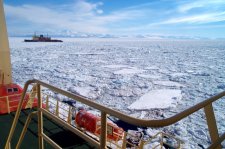The Cruise Begins
At 9 am this morning those of us still in McMurdo dragged ourselves and our gear aboard a two-car snow cat for a short drive across the sea ice to the Nathaniel B. Palmer (or NBP as it's usually called in this acronym-crazed place). The drive across the rough and pitted surface of the late-summer sea ice was a bit disconcerting, although we later learned that the ice is still 3-4 meters (9-12 ft.) thick.
The ship had prepared for our arrival by lying up against the edge of
the ice in the Turning Basin (a large area in McMurdo Sound
kept ice free by the two ice-breakers moored there). We pulled up next
to the ship and unloaded our gear into a cargo net, which the
ship-mounted crane lifted aboard. We then walked the plank across a
narrow moat of icy seawater and onto the deck of our new home.
Once aboard, we began final preparations for the 4 days of non-stop sampling that will begin tomorrow morning when we are scheduled to reach the first IVARS station. IVARS rookies were given a crash course in water collection and sampling methods by veteran IVARS technician Scott Polk. The training proved the adage that 90% of oceanography is filtering water.
For the next 4 days, the IVARS crew will break up into two groups of four: an A.M. group whose members will work from noon to midnight, and a P.M. group that will work from midnight to noon. Our jobs will be to collect and filter water to obtain samples that can be later analyzed for particulate organic carbon and nitrogen, particulate organic phosphate, biogenic silica, chlorophyll, nutrients, bacteria, and preserved samples (more on the significance of these variables in the next few days).
We'll collect the water by lowering an instrument called a CTD over the side of the ship. "CTD" refers to the three parameters that the instrument records: Conductivity (a measure of salinity), Temperature, and Depth. The CTD's circular steel frame also holds 24 "Niskin" bottles, which are long, narrow cylinders with movable stoppers on each end. These stoppers are open when we lower the CTD into the water, but can be closed with an electrical signal at pre-determined depths. Our plan is to lower the CTD to about 200 meters with its bottles open, then collect 12 pairs of water samples at different depths as we pull the instrument back up to the surface.
Once the CTD is safely back inside its hangar, we jump into action. Each team member first gathers about a liter of water from each of the 12 pairs of water bottles, then rushes them next door into the lab to begin filtering for their specific material or organism. The collection and filtering must be done as quickly as possible to prevent the water from warming up, and to preserve its chemical and biological signatures in as natural a state as possible. Because the water is at 28° Fahrenheit, we'll have to wear wool and rubber gloves throughout to keep our hands from freezing.
Filtering is a process of removing materials of interest from seawater by passing the water through small screens with innumerable tiny pores. For our purposes, pore sizes range from 0.6 to 20.0 microns. A micron is one millionth of a meter. Because the pores are so small (to capture the small particles and phytoplankton cells that will be studied), filtering can be a very slow process. Thus our biggest concern is to finish filtering all our bottles before we arrive at the next sampling station. Once filtering is finished, we place the filters into an 80° C freezer or a drying oven (depending on what we're sampling for). We will transport these filters back to VIMS for later analysis.
The IVARS research plan is to do one CTD cast at each of the 24 IVARS stations during the next four days. Doing the math shows that we are going to be plenty busy: 24 stations times 12 Niskin bottles at each station times 7 variables measured for each bottle equals 2,016 bottles o' fun!
2,016 bottles of water in the fridge, 2,016 bottles of water, Filter it down, pass it around, 2,015 bottles of water in the fridge...

